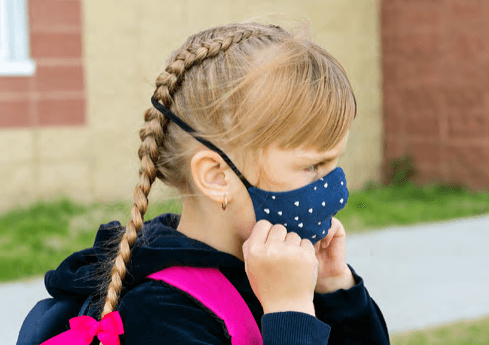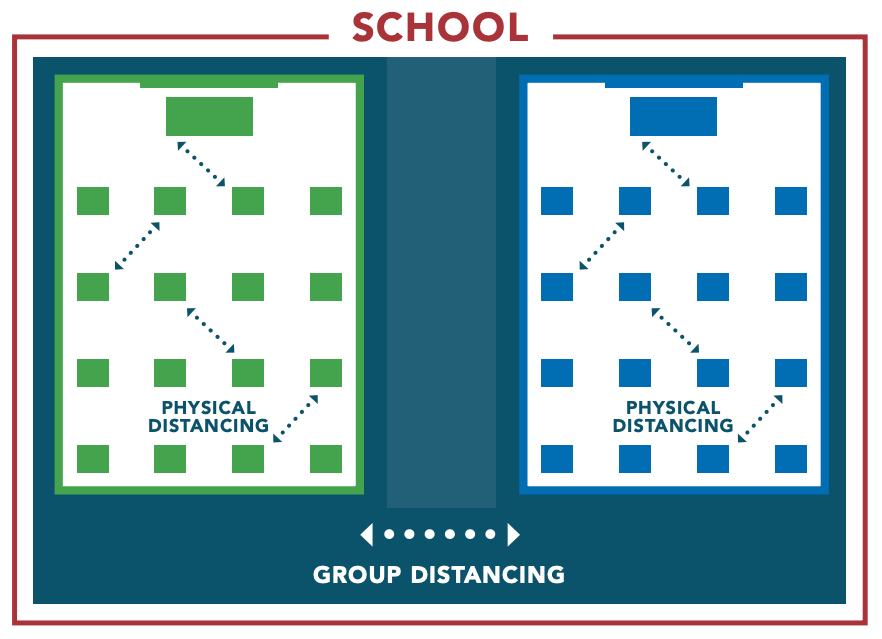In classrooms, teachers and students can limit the spread of COVID-19 by wearing masks, washing hands, maximizing physical distancing, and maximizing group distancing. These recommendations work together to reduce the risk of exposure by close contact, long-range airborne transmission, and fomites. Each strategy complements the others to mitigate the overall risk of transmission. Schools should consider adopting a plan to incorporate these precautions when reopening and establishing a protocol for how to handle any non-compliance.
As part of a multi-layered strategy that includes physical distancing and other control measures, face masks are an effective way to mitigate transmission from individuals who are infectious, even when they do not have symptoms. When worn properly, masks limit the spread of droplets and smaller aerosols when people breathe, speak, cough, or sneeze. This is called “source control.” Masks can also help protect their wearers against COVID-19.

Schools will need to consider a wide range of social, educational, equity, and feasibility factors when deciding on a mask policy. From a safety standpoint, individuals should wear masks as often as possible.
Schools should provide structured training to all students and staff on how to safely choose, wear, care for, clean or discard, and store their masks. For instance, an individual should wash their hands before putting on or removing the mask, only touch the mask by its straps, avoid touching the mask while it is being worn, and change masks if it becomes wet. Individuals should make sure the mask fits snugly to cover the nose bridge, mouth, and chin. Printed guidance, such as infographics from organizations like the WHO and the CDC, should also be posted around the school.
Schools should provide structured training to all students and staff on how to safely choose, wear, care for, clean or discard, and store their masks.
Cloth masks may vary greatly in filtration efficiency and breathability, depending on the fabric and layering. The WHO recommends that masks be at least three layers thick, where the different layers serve to either limit the spread of droplets from the wearer’s mouth or protect the mask from outside contamination and penetration. Additionally, more tightly woven materials, such as cotton fabrics with higher thread counts, are preferable, while elastic materials are not recommended due to the higher pore size and lower filtration efficiency.
Wearing a mask all day long, each and every day will be challenging and frustrating. Over time, ‘mask fatigue’ may set in, and compliance may drop. To limit this, classrooms can incorporate ‘mask free’ time during the day. For example, consider taking masks off during time spent outside when distancing can be maintained, or during quiet classroom time when there is no talking and students can stay distanced, or have half the class leave the room for activities so the remaining group can distance and take masks off. Choosing lower-risk times for breaks from masks may help ensure masks are worn during higher-risk scenarios. The risks of viral transmission during mask breaks will be lower when other interventions, such as healthy building strategies (like higher ventilation and enhanced filtration) and physical distancing, are in place.
It is recommended that everyone wash their hands before and after touching any high-use items or surfaces.
Establish a plan to promote good hygiene practices across the school. Washing hands frequently with soap and water for at least 20 seconds is a simple but effective preventative precaution that addresses fomite transmission and short-range droplet transmission (in the case where infectious droplets land directly on the hand). It is recommended that everyone wash their hands before and after touching any high-use items or surfaces, both to prevent an infectious individual from contaminating a shared surface and to protect others from being infected by a contaminated surface. Everyone should also wash their hands before eating, before touching their face, after using the bathroom, and after coughing, sneezing, or blowing their nose. Handwashing should be incorporated into the school day every time students enter or leave their classrooms and during transitions between activities. Schools could consider setting up handwashing stations with soap and water in classrooms, hallways, or other rooms to help facilitate regular handwashing. If soap and water are unavailable or cannot be frequently accessed without bathroom crowding, hand sanitizer that contains at least 60% ethanol or 70% isopropanol may be used, as it is also effective at inactivating SARS-CoV-2.
Physical distancing lowers the probability that a person either infects someone else or becomes infected by someone else. It limits COVID-19 transmission by reducing the intensity of someone’s exposure to any infectious droplets or aerosols. Physical distancing within schools could be encouraged by moving desks as far away as possible from each other, turning desks to all face the same direction, and assigning seats. Schools should maximize physical distancing and aim for six feet of distance between people. However, due to the high risks associated with school closures and data showing that three-foot distancing can be effective when masks are worn and community spread is low, six-foot distancing should not be used as a bright line cutoff. Three feet is acceptable in the classroom for times that generate lower levels of emissions (e.g. normal talking). This recommendation factors in the lower risk of kids contracting COVID-19 (especially young kids), their lower risk of severe outcomes, and evidence that suggests lower risk of transmitting the virus. Six feet should remain the minimum for activities like loud talking and singing, and for all adult to adult interactions due to adults being more likely to transmit the virus, and more likely to suffer severe outcomes if they contract the virus. Teachers and administrators should continue to maximize their distance from students as much as possible, for as long as possible. Transient interactions of less than three feet, such as passing in the hallway or handing in papers to the teacher, are unavoidable and lower risk due to short duration and universal masking.
To facilitate physical distancing, large outdoor spaces, gymnasiums, cafeterias, and auditoriums could be repurposed as temporary classrooms to improve physical distancing practices for larger class sizes. If using an outdoor space, remember to consider potential effects of weather and temperature. School districts may also consider moving some classes from crowded schools to schools that have extra space to promote physical distancing. Last, create a culture where acts of social solidarity that require physical contact, like hugs, handshakes, and high-fives, are replaced with new contactless signals, like smiles, waves, and giving a thumbs-up.

Whereas physical distancing focuses on preventing infection transmission between classmates in the same room, group distancing aims to reduce the risk of an infection leading to a widespread outbreak in the school. For example, group distancing means that students in one class are kept separate from students in other classes, so these class groups avoid being in the same location (e.g., classroom, cafeteria, playground) at any given time. School-wide gatherings, such as assemblies in the auditorium and school field trips, should be avoided to maintain group distancing.
The strategy of keeping classes separate as much as possible may be more practical for younger students who stay within one class group rather than older grades where class groups often change. In older grades, consider making cohorts of students who take the same core courses and having elective courses be remote so that group distancing can be maintained. This may require schools to adjust class scheduling and be more prescriptive about curriculum tracks that older students can sign up for. Another strategy for specialized teachers is to have them rotate between classrooms instead of having students move between classrooms. This reduces the number of students using a particular desk, the frequency with which students touch common surfaces like door handles, the frequency of close contact interactions in hallways, and the potential exposure to aerosols in classroom air from a sick individual in the previous class.
If there is limited space for a class to practice physical distancing, students within the class could be further organized into smaller pods that stay together throughout the day, including sitting together in class and at lunch and playing together during recess. These pods within larger class groups should still be physically spread out from each other as much as possible. Other countries have found this practice helpful particularly with elementary school students for whom peer socialization is a significant part of school and complete physical distancing might be difficult to enforce.
Group distancing means that students in one class are kept separate from students in other classes, so these class groups avoid being in the same location at any given time.
Frequent hand-washing, including before and after using shared materials, is the most important control strategy that should be reinforced when objects and materials will be shared.
In a school setting, it will be difficult to limit sharing objects, like books, pencils, electronics, and art supplies. Schools can provide an adequate supply of disinfectant wipes in classrooms and throughout the school so individuals can disinfect objects before use. However, frequent hand-washing, including before and after using shared materials, is the most important control strategy that should be reinforced when objects and materials will be shared. In addition, teachers can try to select lessons and activities that do not require shared equipment or close contact. When possible, provide each student their own supplies (e.g., art supplies) that they will use for all activities. If each classroom has limited supplies, consider pooling resources and then rotating supplies between different classrooms on different days, while ensuring adherence to cleaning and disinfection policies.